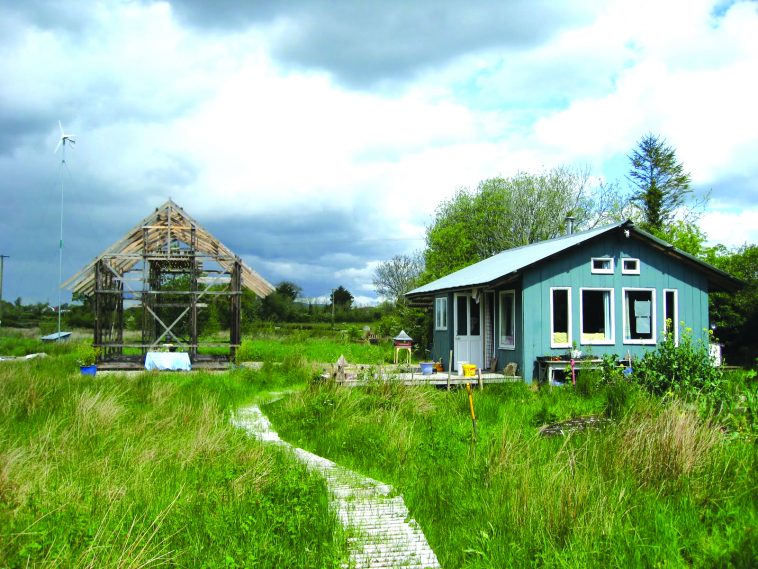Do I require planning permission for external insulation?
ROI:
There is widespread confusion over the planning requirements for externally insulating a house. External insulation suppliers and the Sustainable Energy Authority of Ireland (SEAI) say it may be exempt from planning permission requirements. It is indeed possible to argue that externally insulating a structure can, in many cases, be considered exempted development. This argument would be based on Section 4(1)(h) of the Planning Acts 2000-2010, which states:
4.—(1)The following shall be exempted development for the purposes of this Act— (h) Development consisting of the carrying out of works for the maintenance, improvement or other alteration of any structure, being works which affect only the interior of the structure or works which do not materially affect the external appearance of the structure so as to render the appearance inconsistent with the character of the structure or of neighbouring structures.
If you wish to act on this stated exemption and carry out external insulation works without planning permission, you must ensure, ideally in advance, that the external appearance of the house is not materially altered such that the changes detract from the existing building or from adjoining buildings.
But what happens when you cannot be sure if you would comply with Section 4 (1) (h)? If there is any doubt about whether or not the external insulation will affect its character; you are normally advised to contact your planning authority to discuss it. But, from a phone-call or brief meeting, even they may not be able to provide a straightforward answer upon which to proceed confidently with your project.
Due to the ambiguity over complying with this exemption, those proposing to use external insulation are increasingly resorting to Section 5 of the Planning and Development Acts 2000-2010 for an official declaration. You apply to your local authority using a Section 5 Form (Declaration of Exemption), pay the €80 application fee and provide two site location maps (purchasable online from the Ordnance Survey). The application then goes before an area planner who decides if planning permission is needed. Decisions are generally given within four weeks of its receipt.
There are two possible conclusions; after externally insulating your home, the building with either look
- Similar or identical to how it does now and will not cause projection (mainly of the front elevation) past adjoining elevations, e.g. in a terrace situation, then your works are likely to be exempt under Section 4 (1) (h). or
- Different or substantially different to it does now and your elevations (especially your front elevation) will project past adjoining buildings, then your works are not likely to be exempt under Section 4 (1) (h).
In the case of Protected Structures, Section 57 of the same Act allows for the owner or occupier to make the same request. Section 57 (1) states:
Notwithstanding section 4 (1)(h), the carrying out of works to a protected structure, or a proposed protected structure, shall be exempted development only if those works would not materially affect the character of – (a) the structure, or (b) any element of the structure which contributes to its special architectural, historical, archaeological, artistic, cultural, scientific, social or technical interest.
Your local planning authority can provide you with the details of how to make a Section 57 application; its complexity will vary depending on the local authority and you may require professional help to complete it as detailed drawings of your property will be required in the case of external insulation.
NI:
The situation in NI is similar. In effect, you are permitted to improve or alter a dwelling without the need for planning permission, subject to certain conditions. The most important of these conditions is that ‘the materials used in any exterior work shall be of similar appearance to those used in the construction of the exterior of the existing dwelling house’. Whilst the phrase ‘similar in appearance’ may be open to interpretation, it would seem clear that planning permission is likely to be required for most forms of external cladding or insulation.
As in ROI, it would be sensible to discuss the matter with the local planning authority prior to undertaking significant work. If a formal decision is needed before carrying out the work then it is possible to apply for a Certificate of Lawful Development for a Proposed Use. Forms are available on the Council websites.
Do I need planning permission for internal insulation?
ROI:
No, the installation of internal insulation affects only the interior of the structure and is therefore exempt under Section 4(1)(h) of the Planning Acts 2000-2010 which is set out in the answer to Question 1 above. Protected structures are a different matter and you should consult with your local authority before undertaking any work (a Section 57 can be applied for; detailed drawings may not necessarily be required).
NI:
No, internal insulation does not require permission but if you live in a protected structure you may need a listed building consent so check with the NIEA or your local council.
Do I need planning permission to replace my windows and doors?
ROI:
Upgrading windows and doors does not generally require planning permission as such works are considered to be exempted development under Section 4 (1) (h) of the Planning Acts. However, if a property is within an Architectural Conservation Area (ACA), Special Amenity Area Order or is a Protected Structure, these exemptions do not apply. In these latter instances, property owners are advised to contact their planning authority. It is possible in the case of an ACA for the planning authority to determine works to be exempt if those works would not materially affect the character of the area. Similarly, for Protected Structures, it is possible to make a written request to the planning authority under a Section 57 request. No such provision exists for SAAOs.
NI:
Changes to doors and windows do not normally require consent unless they materially alter the appearance of the dwelling. Same situation as for internal insulation applies to protected structures.
I want to erect a small wind turbine on my land. Do I need permission?
ROI:
If you follow a number of rules, one wind turbine can be placed within the curtilage of a house without planning permission. But to comply with the rules, your garden must be bigger than those most urban dwellers own. These rules are:
- The supporting tower must be a distance of not less than the total structure, turbine included, height plus one metre from any party boundary.
- It can’t be erected on or attached to any building including the house.
- It cannot be placed forward of the front wall of the house.
- It can’t be more than 13 metres in height.
- The rotor diameter cannot exceed 6 metres.
- The clearance distance between the lower tip of the rotor and the ground must be 3 metres or more.
- Maximum noise levels apply.
- It must have a non-reflective finish and be made of specific materials.
- No signs or logos can be exhibited on the turbine.
NI:
Unlike ROI, there are no permitted development rights to erect wind turbines. Planning permission will be required. Any planning application will be determined with regard to the visual impact, noise, shadow flicker, etc.
I want to install solar panels on my roof. Do I need permission?
ROI:
A solar panel can, whether thermal or photovoltaic, be installed on a house, on any building or within the curtilage of a house without planning permission being required as long as:
- The maximum area which can be covered by solar panels is 12sqm or 50% of the total roof area (whichever is lesser).
- The solar panel cannot be raised more than 15cm off the plane of a wall or a pitched roof surface to which it is attached. This distance rises to 50cm for flat roofs and 2 metres from the ground.
- The solar panel must be located 50cm from the edge of any wall or roof on which it is mounted.
- Free standing solar panels cannot be located forward of the front wall of a house or reduce the size of a rear garden’s area to below 25sqm.
NI:
The legislation on the potential for domestic solar panels is quite lengthy, and care is required to ensure that all requirements are met. Basically however, microgeneration systems (i.e. up to 50kW) are permitted provided:
- the panels do not protrude more than 20 cm beyond the plain of any existing roof slope which faces onto and is visible from a road;
- no part exceeds the height of a ridged roof;
- no part is more than 1.5 metres above the plane of any flat roof;
- no part would extend beyond the edge of the existing roof;
- it is not within the curtilage of a listed building, unless listed building consent had been granted; vii) if it is in a World Heritage Site or conservation area it should not be visible from a road.
Stand-alone solar may also be permitted within the curtilage of a dwelling provided the area does not exceed 14 sqm and it is no more than 2 metres in height.
I want to install a ground or air source heat pump – do I need planning permission?
ROI:
Ground source (horizontal or vertical) or air source heat pumps can be installed within the curtilage of a house without planning permission. Again, there are rules to follow:
- The level of the ground can’t be altered by more than one metre above or below the level of the adjoining ground.
- The total area of heat pump(s) installed within a property cannot exceed 2.5sqm.
- The heat pump must be a minimum of 50cm from any edge of the wall or roof on which it is mounted.
- A heat pump cannot be installed forward of the front wall of the house.
- There are maximum noise levels to follow.
NI:
Ground or water source heat pumps are permitted provided the heat pump and its housing are not closer than 3 metres to the site boundary, or exceed 4 metres in height. They should not be closer to a road than the dwelling, should not be in an area of scientific or archaeological interest, or in the curtilage of a listed building (unless listed building consent has been granted).
There should be no more than one air source heat pump within a curtilage, it should be at least 30 metres away from any other dwelling, and it should not be in front of a wall which faces onto a road. The external unit should not be on the roof or exceed 2 metres in height. Other restrictions apply in conservation areas, listed buildings, or world heritage sites.
There’s a small stream on my land, do I need permission for hydro?
ROI:
Small hydroelectric schemes require planning permission. The standard planning application process applies; however, before considering making a planning application, you should read the Central Fisheries Board’s ‘Guidelines on the Planning, Design, Construction & Operation of Small-Scale Hydro-Electric Schemes and Fisheries’ which are available from the Department of Communications, Energy and Natural Resources. These guidelines detail the process which you should follow in developing a hydro scheme. You could also contact the SEAI for further advice.
NI:
Development which involves hydro will normally require planning permission.
My eco property needs a back up heating system – do I need planning permission to install it?
ROI:
Many of those who built passive houses or very energy efficient houses have found a back up heating system is needed in winter. Whatever fuel you intend to use – biomass, gas, oil, etc. – the components of such a system (a chimney or flue, a boiler house and a fuel storage tank or structure), can all be installed without planning permission so long as the capacity of any associated oil storage tank does not exceed 3,500 litres.
NI:
Normal domestic heating systems do not normally require planning permission. Oil or liquefied petroleum gas tanks are permitted of up to 3,500 litres, provided they are not more than 3 metres above ground level or face onto a road. On listed buildings such tanks require listed building consent.
Note: In ROI full details of the exempted development rights for renewable technologies are contained in the Planning and Development Regulations 2007. These are available online or from the Department of Environment, Community and Local Government.
In NI the full legislative requirements can be found in the Planning (General Permitted Development) Order (NI) 2015. This is available online. If in any doubt the legislation should be thoroughly checked or advice taken from a planning expert.
ROI: Brendan Buck, BPS Planning consultants, Dalkey, Co. Dublin, Tel: 087 2615871. www.buckplanning.ie
NI: David Donaldson, Donaldson Planning, Hollywood, Co. Down BT18 9AE. Tel: 9042 3320 www.donaldsonplanning.com











